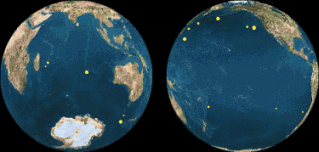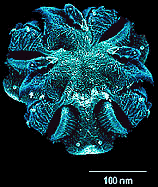Priority:
EID Code:
Niche:
Ultra (Global Pandemic)
ßehemoth
pathogen/decomposer
DO NOT mail
DO NOT access Haven
DO NOT copy
PURGE AFTER DECRYPT
Taxonomy:
Formal nomenclature awaiting declassified release to Linnean Society. Eventual outgroup clade to be at supraDomain level.
Description:
Unique heterotrophic microbe, 200-250nm diameter. Opportunistic freeliver/pathogen. Genome 1.1M (pRNA template): nonsense codons <0.7% of total.
Biogeography:
Originally native to hydrothermal deep-sea environments; 14 relic populations confirmed. Can also exist in intracellular environments with salinity <30ppt and/or temperatures ranging from 4-60°C. A secondary strain has been found with advanced adaptations for intracellular existence.

Confirmed populations of ßehemoth as of 17/11/51. There are no known Atlantic populations.
Evolution/Ecology:
ßehemoth is the only known organism with truly terrestrial origins, predating the Martian Panspermia event by approximately 300 million years. The existence of a secondary strain geared specifically to the intracellular environment is reminiscent of the Precambrian serial endosymbiosis which produced mitochondria and other modern subcellular organelles. Homeostasis is much more costly for ßehemoth in its native habitat than within a host cell. In the latter environment the microbe generates surplus ATP, resulting in abnormal growth among certain deepwater fish, and increased strength and stamina among infected humans. Since humans and ßehemoth have had no time to co-adapt, however, such benefits are temporary at best; ßehemoth also disrupts short-chain sulfur-containing proteins, causing massive deficiency syndromes in its human hosts (see below).
Notable Histological and Genetic Features:
No phospholipid membranes: body wall consists of accreted mineralized sulfur/phosphate compounds. Genetic template based upon Pyranosal RNA, also used for catalysis of metabolic reactions. Resistant to g-radiation (1 megarad not effective). The ßehemoth genome contains Blachford genes analagous to the metamutators of Pseudomonas; these allow it to dynamically increase mutation rate in response to environmental change, and are probably responsible for its ability to fool steroid receptors on the host cell membrane.

Isolated ßehemoth particle, primary strain.
Modes of Attack:
Freed from the rigors of its natural environment, ßehemoth assimilates several inorganic nutrients 26-84% more efficiently than its closest terrestrial competitors. This is especially problematic when dealing with sulfur. Free-living ßehemoth is theoretically capable of bottlenecking even that extremely common element; this is the primary ecological threat. The organism is, however, more comfortable within the bodies of vertebrate homeotherms, which provide warm, stable, and nutrient-rich environments reminiscent of the primordial soup. ßehemoth enters the cell via receptor-mediated endocytosis; once inside it breaks down the phagosomal membrane prior to lysis, using a 532-amino listeriolysin analog. It then competes with the host cell for nutrients. Host death results from any of several dozen proximal causes including renal/hepatic failure, erythromytosis, CNS disorders, blood poisoning, and opportunistic infections.
Vertebrate hosts serve as reservoirs which periodically reinoculate the nanobe into the external environment, increasing the chance of self-sustaining outbreaks.
Diagnostics:
Methionine labeling is effective in culture. Free-living ßehemoth in concentrations of greater than 1.35 billion/cc exert detectable effects on soil pH, conductivity, porphyrin counts, and chlorophylls A and B; the extent of these effects varies with baseline conditions. ßehemoth can be infered by the presence of d-cysteine and d-cystine in the blood of asymptomatic patients (unsuccessful attempts to cleave bound sulfur sometimes stereoisomerizes the molecule).
Trajectory:
Long-term forecasts are inherently unreliable due to complexity of the variable set. If current trends continue, however, ßehemoth may ultimately exclude all competing life forms between 62°N and S latitude within 50-100 years. The fate of polar components cannot be assessed at this time. Sensitivity analysis generates 95% confidence limits of 50 to 94 years for EL90.

ßehemoth projected 2-year distributional trajectory, based on Monte Carlo simulations (4,000,000 runs) Bright and dark distributions represent lower and upper limits, respectively, of the 95% confidence interval. All runs assume no deliberate propagation on the part of terrorists.
Present Status:
4,800km² sterilized at last report. 426,000km² under immediate threat.
Recommendations:
classified.